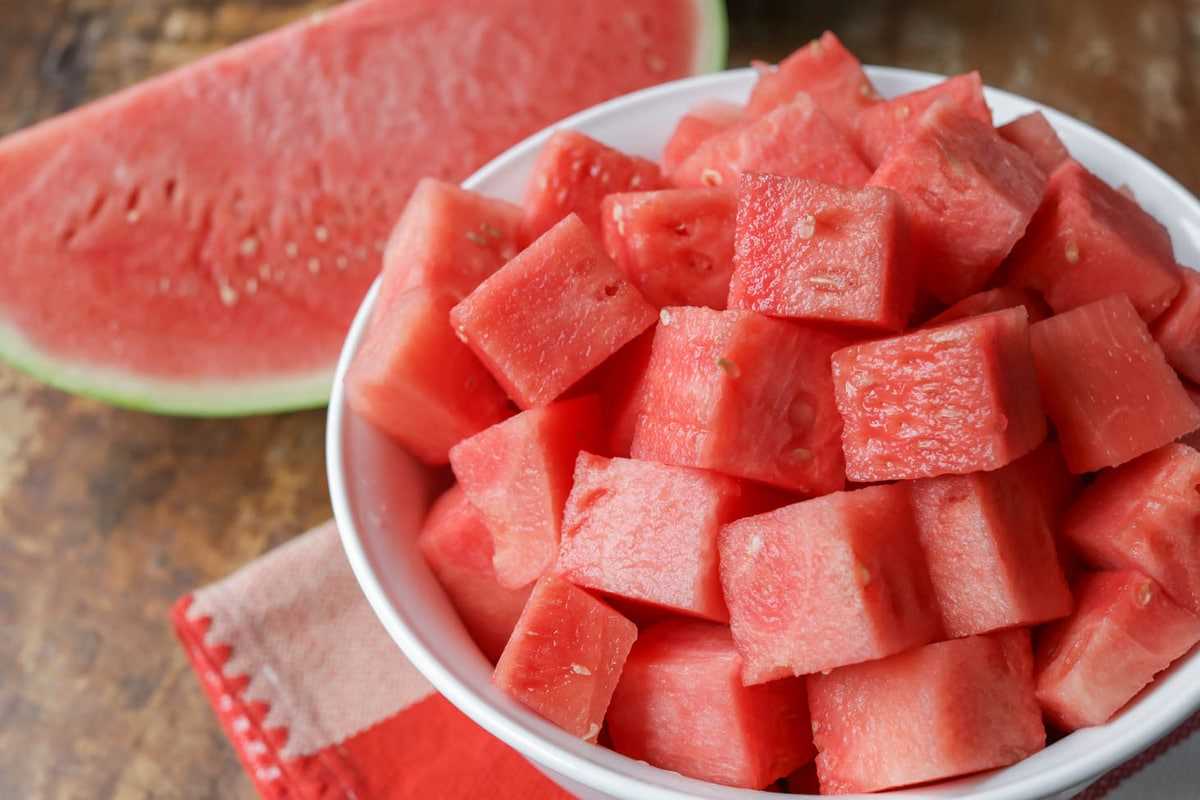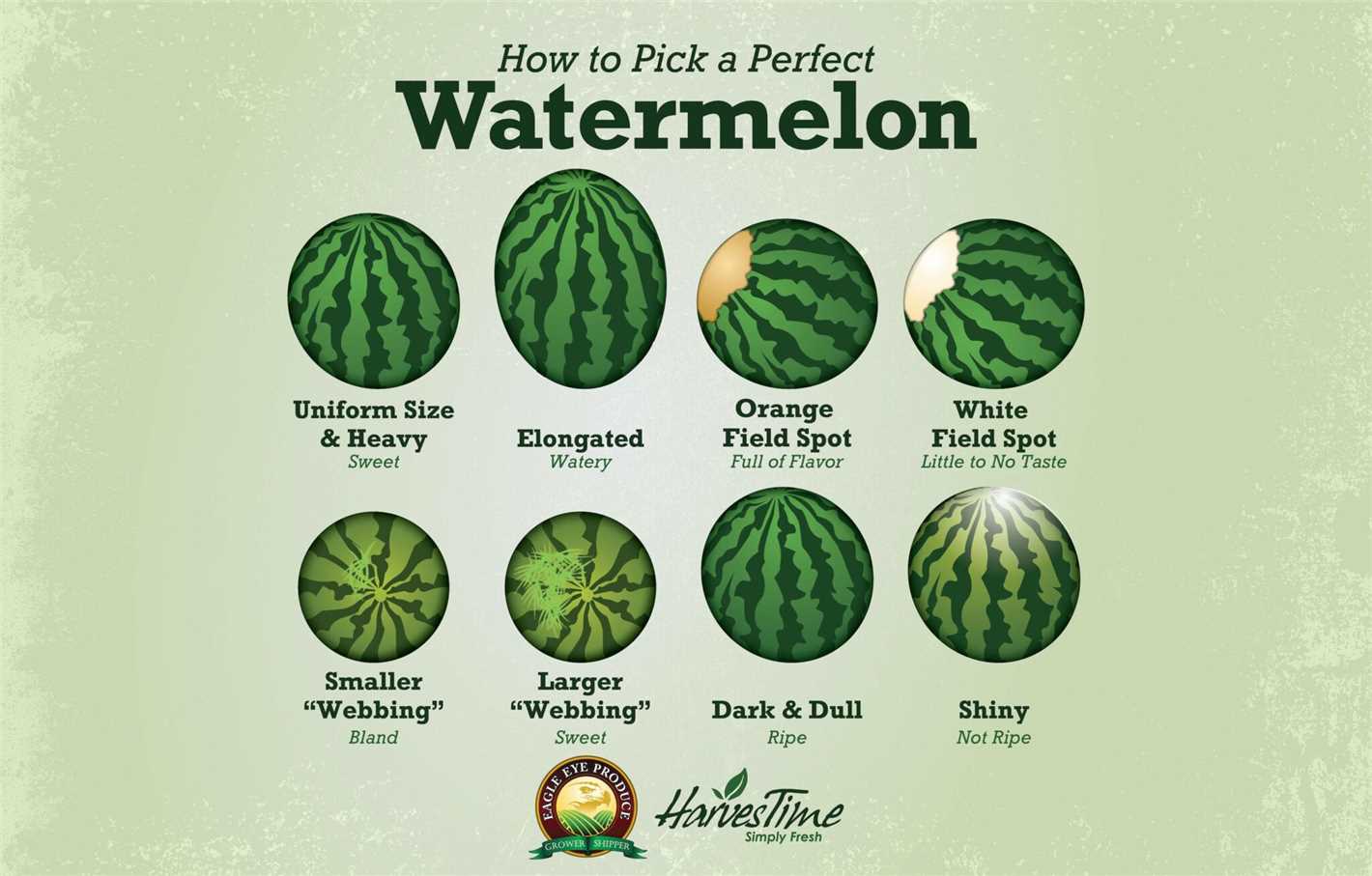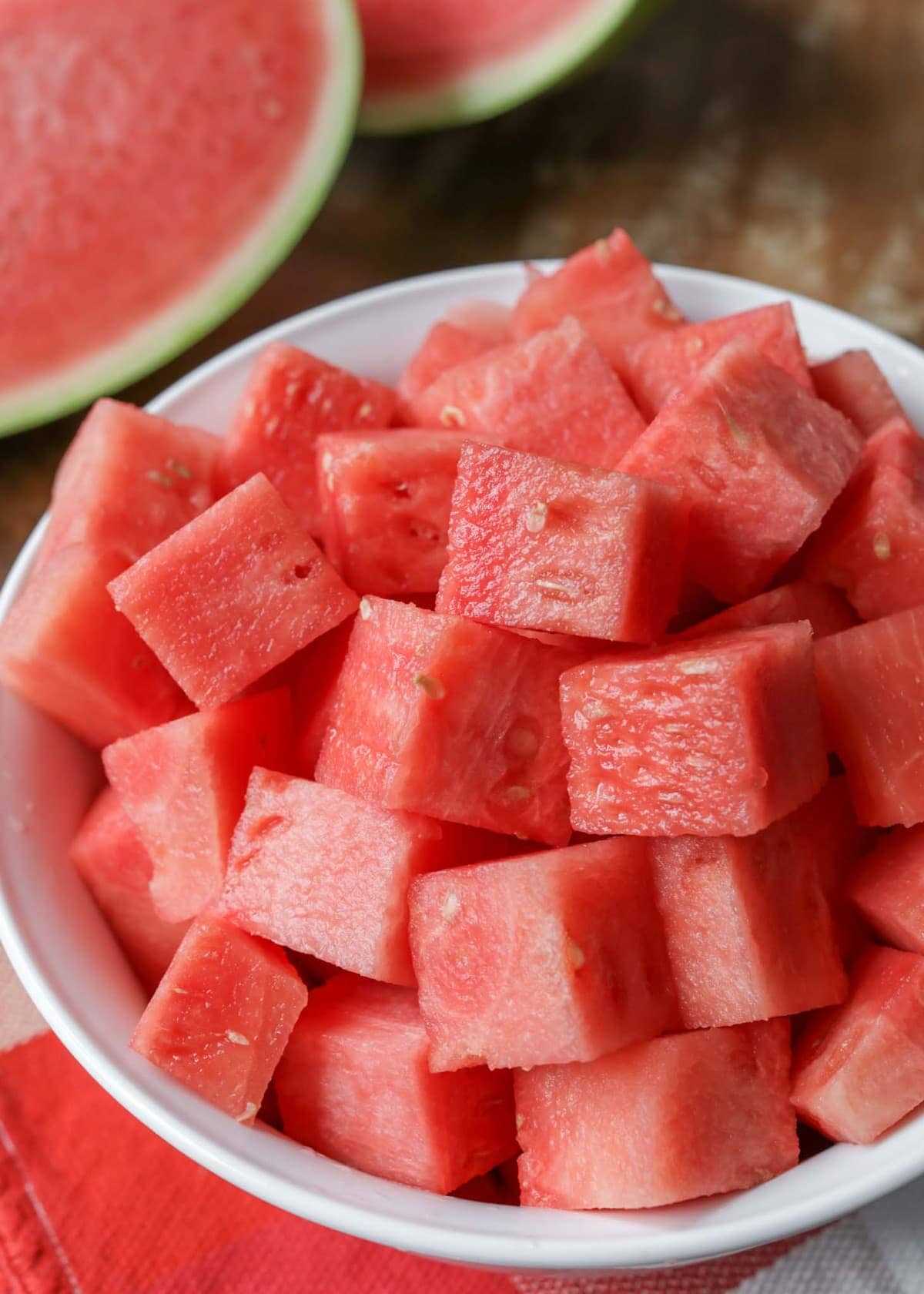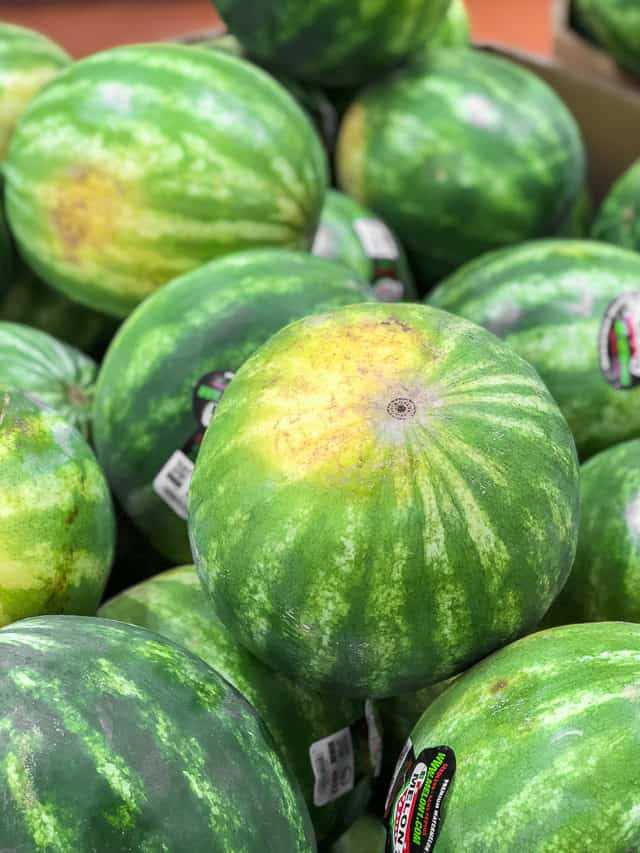- Tips for Growing Large and Sweet Watermelons
- 1. Choose the right varieties
- 2. Provide plenty of space
- 3. Give them plenty of sunlight
- 4. Maintain proper soil moisture
- 5. Use mulch
- 6. Support the growing fruit
- 7. Control pests and diseases
- 8. Monitor for ripeness
- 9. Enjoy your hard work!
- Choosing the Right Variety
- 1. Growing season:
- 2. Size:
- 3. Flavor:
- 4. Texture:
- 5. Monitoring Soil Moisture
- 6. Adjusting Watering Based on Plant Stage
- Controlling Pests and Diseases
- 1. Pest Identification
- 2. Integrated Pest Management (IPM)
- 3. Crop Rotation
- 4. Companion Planting
- 5. Row Covers
- 6. Regular Inspection and Monitoring
- 7. Organic Pest Control
- 8. Proper Watering and Fertilization
- 9. Remove Infected Plants
- Supporting Healthy Growth
- 1. Proper Soil Preparation
- 2. Adequate Spacing and Trellising
- 3. Regular Watering
- 4. Mulching
- 5. Fertilization
- 6. Pollination Assistance
- 7. Regular Pest and Disease Monitoring
- 8. Harvesting at the Right Time
- Pruning and Training Techniques
- 1. Pruning
- 2. Training Techniques
- Harvesting at the Right Time
- Check the Drying Tendril
- Inspect the Field Spot
- Thump Test
- Size and Appearance
- Consult the Days to Maturity
- Harvesting Tips:
- Storing and Enjoying Your Watermelons
- 1. Harvesting at the right time
- 2. Cleaning the watermelon
- 3. Proper storage
- 4. Using the refrigerator
- 5. Enjoying your watermelon
- Conclusion
- “Question-Answer”
- What are some tips for growing large watermelons?
- What is the best variety of watermelon for growing large and sweet fruits?
- What is the ideal amount of space that should be provided for watermelon plants to grow?
- How often should watermelon plants be watered?
- What are some common pests and diseases that can affect watermelon plants?
- How can I ensure that my watermelon plants receive enough nutrients?
- “Video” Tricks to Growing Watermelons
Growing watermelons can be a rewarding and fun experience. There’s nothing quite like biting into a juicy, sweet watermelon on a hot summer day. However, growing large and sweet watermelons requires some knowledge and effort. In this article, we will share some tips and tricks to help you achieve the best possible results in your watermelon harvest.
Choose the right variety: Not all watermelon varieties are created equal. Some are known for their large size, while others are prized for their sweetness. Research different watermelon varieties and choose one that suits your taste preferences and growing conditions. Popular varieties for growing large and sweet watermelons include Crimson Sweet, Charleston Gray, and Jubilee.
Start with quality seeds: The foundation of a successful watermelon harvest is quality seeds. Look for seeds that are well-known and trusted, and avoid purchasing seeds from unknown or unreliable sources. You can also consider saving seeds from your own watermelons, but be aware that this may result in some variety variation.
Provide adequate space: Watermelon plants need plenty of space to grow, so make sure to give them enough room to spread out. Each plant should have at least 6-8 feet of space in all directions. This will allow the vines to grow freely and help prevent overcrowding, which can lead to smaller and less sweet watermelons.
Optimize soil conditions: Watermelons thrive in well-draining soil that is rich in organic matter. Before planting, prepare the soil by adding compost or well-rotted manure to improve its fertility. Aim for a pH level of around 6.0-6.8, which is ideal for watermelon growth. Regular soil testing can help you monitor and adjust the soil conditions as needed.
Provide adequate water and nutrients: Watermelons are mostly made up of water, so it’s important to provide them with regular and consistent watering. Aim to keep the soil evenly moist throughout the growing season, but be careful not to overwater, as this can lead to disease and fruit cracking. Additionally, watermelons are heavy feeders and require plenty of nutrients. Consider using a balanced fertilizer or organic compost to provide them with the necessary nutrients.
Protect from pests and diseases: Watermelons are susceptible to various pests and diseases, such as aphids, spider mites, and powdery mildew. Regularly inspect your plants for any signs of damage or infestation, and take appropriate measures to control pests and prevent diseases. This may include using organic insecticides, practicing crop rotation, or using physical barriers.
Harvest at the right time: Knowing when to harvest your watermelons is crucial for achieving the best flavor and sweetness. Pay attention to the variety’s recommended days to maturity and look for other signs of ripeness, such as a dulling of the skin color, a hollow sound when tapped, and a dry tendril. Avoid harvesting watermelons too early, as they may lack in sweetness and flavor.
By following these tips and tricks, you’ll be well on your way to growing large and sweet watermelons that are bound to impress family and friends. Enjoy the fruits of your labor and savor the taste of summer!
Tips for Growing Large and Sweet Watermelons
1. Choose the right varieties
When selecting watermelon varieties, choose those known for producing large and sweet fruit. Some popular varieties include:
- Crimson Sweet: This variety produces medium to large watermelons with a deep red and sweet flesh.
- Sugar Baby: Known for its small size, this variety still packs a lot of sweetness.
- Jubilee: Jubilee watermelons are large and have a high sugar content, making them a favorite among watermelon enthusiasts.
2. Provide plenty of space
Watermelon plants need space to spread out and thrive. Make sure to plant them at least 6 feet apart to give each plant enough room to grow without competing with its neighbors for resources.
3. Give them plenty of sunlight
Watermelons are sun-loving plants and require at least 8 hours of direct sunlight per day. Choose a location in your garden that receives full sun and avoid planting them in shady areas.
4. Maintain proper soil moisture
While watermelons need plenty of water, it’s important to strike the right balance to avoid overwatering or underwatering. Keep the soil consistently moist, but not waterlogged, by watering deeply once or twice a week, depending on rainfall.
5. Use mulch
Applying a layer of organic mulch, such as straw or wood chips, around your watermelon plants can help conserve moisture and suppress weed growth. This will also keep the soil temperature more consistent, which can result in larger and sweeter fruit.
6. Support the growing fruit
As watermelons grow, their weight can cause them to droop or even break from the vine. Use cloth slings, old pantyhose, or netting to support the fruit and prevent damage.
7. Control pests and diseases
Keep an eye out for common watermelon pests, such as aphids, cucumber beetles, and squash bugs. Use natural pest control methods, like insecticidal soap or neem oil, to protect your plants. Additionally, practice good garden hygiene by removing any diseased or rotting fruit to prevent the spread of diseases.
8. Monitor for ripeness
Watermelons are ripe and ready for harvest when the underside turns from green to yellow and the fruit sounds hollow when tapped. Gently twist or cut the fruit from the vine to avoid damaging the plant.
9. Enjoy your hard work!
Once you’ve successfully grown large and sweet watermelons, savor the delicious fruits of your labor. Whether you enjoy them fresh, in salads, or in refreshing summer beverages, your homegrown watermelons are sure to taste extra sweet and satisfying.
| Variety | Fruit Size | Sweetness |
|---|---|---|
| Crimson Sweet | Medium to large | High |
| Sugar Baby | Small | High |
| Jubilee | Large | High |
Choosing the Right Variety
When it comes to growing large and sweet watermelons, choosing the right variety is crucial. Here are some factors to consider when selecting a watermelon variety:
1. Growing season:
Watermelon varieties can be categorized as early maturing, mid-season, or late maturing. Consider the length of your growing season and choose a variety that will have enough time to ripen before the first frost.
2. Size:
Watermelons come in various sizes, from small personal-sized ones to massive giant watermelons. Consider the available space in your garden and choose a variety that fits your needs.
3. Flavor:
Different watermelon varieties have different flavor profiles. Some varieties are sweeter, while others have a more subtle taste. Consider your preferences and choose a variety that suits your taste buds.
4. Texture:
 “>
“>
Watermelons can have different textures, ranging from crisp and juicy to tender and delicate. Decide whether you prefer a crunchy texture or a softer, melt-in-your-mouth experience.
5. Disease resistance:
Some watermelon varieties are more resistant to common diseases and pests. Check for disease-resistant varieties if you want to minimize the use of pesticides and fungicides in your garden.
6. Growing requirements:
Consider the specific growing requirements of each watermelon variety, such as soil type, sunlight, and water needs. Choose a variety that matches your garden’s conditions to ensure optimal growth and yield.
By considering these factors, you can select the right watermelon variety that will thrive in your garden and provide you with large and sweet fruits to enjoy during the summer months.
Preparing the Soil
Preparing the soil is a critical step in growing large and sweet watermelons. By creating the right environment for your watermelon plants, you can ensure optimal growth and fruit development. Here are some tips for preparing the soil:
- Choose the right location: Watermelons require plenty of sunlight, so select a spot in your garden that receives at least 6-8 hours of direct sunlight each day.
- Clear the area: Remove any weeds, rocks, or debris from the chosen location. Weeds can compete with watermelon plants for nutrients and hinder their growth.
- Test the soil: Conduct a soil test to determine its pH level and nutrient content. Watermelons prefer slightly acidic soil with a pH level between 6.0 and 6.8. Adjust the pH level if necessary using lime or sulfur.
- Improve drainage: Watermelons thrive in well-draining soil. If your soil retains too much water, consider amending it with organic matter like compost, peat moss, or sand to improve drainage.
- Add nutrients: Watermelons are heavy feeders and require ample amounts of nutrients. Before planting, consider incorporating aged compost or well-balanced organic fertilizers into the soil to provide essential nutrients.
- Loosen the soil: Use a garden fork or tiller to loosen the soil to a depth of at least 12-18 inches. This will help the watermelon roots penetrate the soil easily and access nutrients.
- Remove any obstacles: Remove any large stones, roots, or other obstacles that could impede root growth or cause deformities in the developing watermelons.
Following these steps will ensure that your watermelon plants have a healthy and nutrient-rich soil environment to thrive in and produce large and sweet fruits.
Providing Proper Watering
Watering plays a crucial role in the growth and development of watermelons. It is important to provide regular and adequate water to ensure the plants have enough moisture and nutrients for optimal growth. Here are some tips for providing proper watering for your watermelon plants:
1. Deep, Frequent Watering
Watermelons have deep root systems, so it is important to water deeply and thoroughly rather than sprinkling the surface lightly. This helps the water reach the roots and encourages deep root growth. Water the plants deeply at least once a week, and increase the frequency during hot and dry periods.
2. Watering in the Morning
It is best to water watermelon plants in the early morning before the sun is at its strongest. This allows the water to soak into the soil and be absorbed by the roots before it evaporates. Avoid watering in the evening as the foliage may remain damp overnight, increasing the risk of disease.
3. Using a Drip Irrigation System
A drip irrigation system is highly recommended for watering watermelons. This system delivers water directly to the base of the plants, reducing the risk of wetting the foliage and minimizing water loss through evaporation. It also allows for controlled and consistent watering, ensuring the plants receive the right amount of water.
4. Mulching
 5. Monitoring Soil Moisture
5. Monitoring Soil Moisture
Regularly check the moisture level of the soil by inserting your finger into the soil up to the first knuckle. If the soil feels dry at that depth, it is time to water. Avoid letting the soil become waterlogged, as this can lead to root rot and other issues. Proper drainage is essential.
6. Adjusting Watering Based on Plant Stage
Watermelon plants require different amounts of water at different growth stages. Provide more water during the early growth stages and as the fruits are developing. However, reduce watering about two weeks before harvest to help concentrate the sweetness of the watermelons.
By following these watering tips, you can provide the proper moisture for your watermelon plants and help them grow large and sweet fruits.
Controlling Pests and Diseases
Pests and diseases can be a major challenge when growing watermelons, but with proper control measures, you can minimize the damage and ensure healthy plant growth. Here are some helpful tips for controlling pests and diseases:
1. Pest Identification
Knowing the pests that commonly affect watermelons can help you choose the right control method. Look out for common watermelon pests like aphids, cucumber beetles, and squash bugs. Regularly inspect your plants for signs of pest activity.
2. Integrated Pest Management (IPM)
Adopting an Integrated Pest Management approach can be highly effective in controlling pests. This method involves using a combination of preventive measures, cultural controls, biological controls, and targeted pesticide applications as a last resort.
3. Crop Rotation
Rotating watermelon crops is essential for preventing the buildup of pests and diseases in the soil. Avoid planting watermelons in the same area for consecutive years. Rotate with different crops like beans or corn to disrupt the life cycle of pests and reduce disease pressure.
4. Companion Planting
Planting companion plants that repel pests can be a natural way to control infestations. Marigolds, for example, are known to deter pests like aphids and squash bugs. Consider interplanting marigolds or other pest-repellent plants with your watermelons.
5. Row Covers
Using row covers can help protect young watermelon plants from insect damage. These covers act as a physical barrier, preventing pests from accessing the plants. Make sure the covers are properly secured and allow enough space for the plants to grow.
6. Regular Inspection and Monitoring

Regularly inspect your watermelon plants for signs of pests or diseases. Early detection can help you take immediate action and prevent further damage. Monitor the plants closely, paying attention to any changes in color, texture, or growth patterns.
7. Organic Pest Control
If possible, opt for organic pest control methods. This includes using organic insecticides, such as neem oil or insecticidal soap, that are less harmful to beneficial insects and pollinators. Organic practices also focus on improving soil health, which can help plants resist pests and diseases naturally.
8. Proper Watering and Fertilization
Avoid overwatering your watermelon plants, as this can create favorable conditions for diseases. Make sure the soil is well-drained and provide water at the base of the plants to minimize foliage moisture. Additionally, maintaining proper fertilization levels can help boost plant health and disease resistance.
9. Remove Infected Plants
If you notice any signs of disease or severe pest infestation on a plant, remove it immediately. This prevents the spread of diseases and protects other healthier plants. Properly dispose of the infected plant to avoid further contamination.
By implementing these strategies and staying vigilant, you can effectively control pests and diseases in your watermelon garden. Healthy plants will lead to larger and sweeter watermelons for your enjoyment.
Supporting Healthy Growth
1. Proper Soil Preparation
Start by preparing the soil before planting your watermelon seeds. Watermelons thrive in well-drained soil with a pH level between 6.0 and 6.8. Remove any weeds, rocks, or debris from the planting area and loosen the soil with a garden fork or tiller. Incorporate organic matter, such as compost or well-rotted manure, into the soil to improve its fertility and drainage.
2. Adequate Spacing and Trellising

Watermelon plants require ample space to grow and spread. Allow at least 2-3 feet of space between each plant and maintain a distance of 6-8 feet between rows. Consider using trellises or supports to provide vertical growth for your watermelon plants. This can help ensure proper air circulation, reduce disease risks, and prevent the fruits from resting directly on the ground.
3. Regular Watering
Watermelons have high water requirements, especially during hot summer months. Water the plants regularly, providing 1-2 inches of water per week. It’s best to water deeply and infrequently rather than shallowly and frequently. This encourages the plants to develop deep root systems, which are better equipped to access water and nutrients from the soil.
4. Mulching
Applying a layer of organic mulch around your watermelon plants can help conserve soil moisture, suppress weeds, and regulate soil temperature. Use straw, wood chips, or compost as mulch, and apply it around the base of the plants, avoiding direct contact with the stems. This will provide a protective barrier and create optimal growing conditions.
5. Fertilization

Watermelons thrive in nutrient-rich soil. Before planting, incorporate a slow-release, balanced fertilizer into the soil, following the package instructions. Additionally, you can apply a side-dressing of compost or a nitrogen-rich fertilizer once the vines start to grow. Be cautious not to over-fertilize, as this can lead to excessive foliage growth at the expense of fruit development.
6. Pollination Assistance
Watermelon plants rely on pollinators, such as bees, to transfer pollen between the male and female flowers. If you notice a lack of bee activity in your garden, you can assist with hand pollination. Take a small, soft brush or cotton swab and gently touch the inside of each male flower to collect pollen. Then, transfer the collected pollen to the inside of the female flowers.
7. Regular Pest and Disease Monitoring
Keep a close eye on your watermelon plants for any signs of pests or diseases. Common pests include aphids, cucumber beetles, and spider mites. If you spot any pests, take appropriate measures, such as using insecticidal soap or introducing beneficial insects like ladybugs. Also, watch for signs of diseases like powdery mildew or bacterial wilt, and treat them promptly to prevent further damage.
8. Harvesting at the Right Time
Proper timing is crucial for harvesting sweet and juicy watermelons. Look for signs of maturity, such as a dull skin color, a dried stem, and a yellow or cream-colored underside. Gently tap the watermelon, and if it produces a deep, hollow sound, it is likely ripe. Cut the fruit from the vine using a sharp knife and enjoy your homegrown, flavorful watermelons!
Pruning and Training Techniques
Pruning watermelon plants is an essential step in maximizing the growth and yield of large and sweet watermelons. Pruning helps in controlling the number of vines, removing unwanted shoots, and redirecting the plant’s energy towards fruit production. Additionally, training techniques help in supporting the vines and preventing them from sprawling all over the garden.
1. Pruning
Pruning watermelon plants involves removing lateral shoots and limiting the number of vines to a few vigorous ones. This helps in reducing competition for nutrients and allows the plant to focus its resources on producing high-quality fruits. Here are some pruning tips:
- Start pruning when the plants have developed several true leaves and are well-established.
- Identify the main vine, which is usually the thickest and strongest one.
- Remove all lateral shoots that emerge from the leaf nodes along the main vine.
- Leave a few lateral shoots near the base of the plant to promote airflow and prevent direct contact between the fruits and soil.
- Remove any suckers that grow from the base of the plant.
2. Training Techniques
Training techniques help in supporting the watermelon vines and preventing them from sprawling all over the garden. They also promote better air circulation, reduce the risk of diseases, and make harvesting easier. Here are some training techniques to consider:
- Use trellises or stakes: Set up trellises or stakes near the watermelon plants and gently tie the vines to them using soft twine or cloth. This will provide support and keep the vines off the ground.
- Prune excess foliage: Remove any excessive foliage that blocks sunlight from reaching the fruit. This will help in promoting better fruit development and ripening.
- Use fruit slings: For extra support, you can use fruit slings made of fabric or netting to cradle the developing fruit. This will prevent the weight of the fruit from damaging the vine.
Remember to regularly check and adjust the ties or supports as the watermelon plant grows. Pruning and training techniques require consistent attention and care throughout the growing season.
| Benefits | Explanation |
|---|---|
| Improved air circulation | Reduces the risk of diseases by allowing better airflow around the leaves and fruits. |
| Higher quality fruits | Redirects the plant’s energy towards fruit production, resulting in larger and sweeter watermelons. |
| Easier maintenance | Facilitates harvesting and reduces the need for extensive pruning and trellising later in the season. |
| Space-saving | Allows for compact growth and prevents the watermelon vines from taking over the entire garden. |
Harvesting at the Right Time
Harvesting watermelons at the optimal time is crucial to ensure they are sweet, flavorful, and juicy. Here are some tips on how to determine when to harvest your watermelons:
Check the Drying Tendril
One way to tell if a watermelon is ready for harvest is by checking the tendril closest to the fruit. The tendril is a small, curly vine located where the watermelon attaches to the main stem. When the watermelon is ripe, the tendril will turn brown and dry up.
Inspect the Field Spot
The field spot is the area where the watermelon rested on the ground. A ripe watermelon will have a yellow or creamy yellow field spot. If the field spot is still white or green, the watermelon is likely not fully ripe.
Thump Test
Although it may sound unconventional, many experienced watermelon growers swear by the thump test. Gently tap the watermelon with your knuckles and listen to the sound it makes. A ripe watermelon will produce a hollow, deep sound whereas an unripe one will produce a dull, flat sound.
Size and Appearance
Another indicator of a watermelon’s ripeness is its size and appearance. A ripe watermelon will have a uniform shape and feel heavy for its size. The skin should be firm and have a dull, matte finish rather than a shiny one.
Consult the Days to Maturity
When planting watermelon seeds or transplants, make note of the days to maturity provided by the variety or seed packet. This is an estimation of how long it will take for the watermelon to reach its full maturity. Use this as a general guideline but remember that factors like weather and growing conditions can influence the actual harvest time.
Harvesting Tips:
- Use a sharp knife or pruning shears to cut the watermelon from the vine, leaving a few inches of stem attached to the fruit.
- Handle the watermelon with care to avoid bruising or damage.
- Store harvested watermelons in a cool, dry place or in the refrigerator to maintain their freshness and flavor.
By following these guidelines, you can ensure that you harvest your watermelons at the right time for the best taste and quality.
Storing and Enjoying Your Watermelons
Once you’ve successfully grown large and sweet watermelons, it’s important to store them properly to maintain their taste and quality. Here are some tips for storing and enjoying your watermelons:
1. Harvesting at the right time
It’s essential to harvest watermelons at the right time to ensure they are ripe and flavorful. Look for signs such as a duller sheen or yellowing of the tendrils near the fruit. Thump the watermelon and listen for a deep, hollow sound.
2. Cleaning the watermelon

Prior to storing or consuming your watermelon, make sure to wash it thoroughly to remove any dirt or bacteria. Use clean water and a vegetable brush to scrub the surface of the watermelon gently.
3. Proper storage
Watermelons should be stored in a cool and dry place. Ideally, they should be kept at a temperature between 50-60°F (10-15°C). Avoid keeping them in areas with high humidity, as this can cause them to spoil more quickly.
It’s best to store watermelons on a flat surface to avoid any damage or bruises. Avoid stacking them on top of each other, as this can lead to unnecessary pressure and spoilage.
4. Using the refrigerator
Watermelons can be stored in the refrigerator, especially if you want to enjoy the refreshing taste of chilled watermelon slices. However, it’s important to note that refrigeration can alter the texture and flavor of the fruit.
If you decide to refrigerate your watermelon, wrap it in plastic wrap or place it in an airtight container to prevent it from absorbing any odors or flavors from other foods in the refrigerator. Cut watermelon should be stored in a sealed container or wrapped tightly in plastic wrap to maintain its freshness.
5. Enjoying your watermelon
Watermelons can be enjoyed in various ways. Here are a few ideas:
- Cut the watermelon into slices and enjoy it as a refreshing snack.
- Blend watermelon chunks with ice for a delicious and hydrating watermelon slushie.
- Use watermelon as a base for a summer salad by combining it with feta cheese, cucumber, and mint.
- Make watermelon popsicles by pureeing the fruit and freezing it in popsicle molds.
- Create a watermelon salsa by combining diced watermelon with jalapeno, red onion, lime juice, and cilantro.
Conclusion
By following these tips for storing and enjoying your watermelons, you can ensure that they remain delicious and fresh for as long as possible. Whether you prefer to enjoy your watermelon chilled, in salads, or as a refreshing snack, there are countless ways to savor the sweet juiciness of this beloved summer fruit.
“Question-Answer”
What are some tips for growing large watermelons?
There are several tips for growing large watermelons. First, make sure to choose the right variety of watermelon that is known for its large size. Next, provide the plants with plenty of space to grow by placing them at least 6 feet apart. Additionally, water the plants deeply and consistently, and provide them with a steady supply of nutrients. Finally, monitor the plants closely for any signs of pests or diseases and take appropriate action if necessary.
What is the best variety of watermelon for growing large and sweet fruits?
There are several varieties of watermelon that are known for their large and sweet fruits. Some popular options include “Sugar Baby,” “Crimson Sweet,” and “Charleston Gray.” These varieties are known for their high sugar content and delicious flavor.
What is the ideal amount of space that should be provided for watermelon plants to grow?
Watermelon plants require plenty of space to grow, as they have long vines that spread out. It is recommended to plant the watermelon plants at least 6 feet apart to allow for proper growth and airflow. This spacing helps to prevent overcrowding and allows the plants to receive adequate sunlight and nutrients.
How often should watermelon plants be watered?
Watermelon plants need a consistent and deep watering routine. It is recommended to water the plants deeply once or twice a week, depending on the weather conditions. The soil should be kept evenly moist but not overly saturated. Avoid overwatering, as this can lead to root rot and other issues.
What are some common pests and diseases that can affect watermelon plants?
Watermelon plants can be susceptible to various pests and diseases. Some common pests include aphids, cucumber beetles, and squash bugs. These pests can feed on the leaves and fruits, causing damage to the plants. In terms of diseases, watermelon plants can be affected by powdery mildew, downy mildew, and root rot. It is important to monitor the plants closely for any signs of infestation or disease and take appropriate measures to control and prevent them.
How can I ensure that my watermelon plants receive enough nutrients?
To ensure that watermelon plants receive enough nutrients, it is recommended to prepare the soil properly before planting. Add organic matter, such as compost or well-rotted manure, to enrich the soil with nutrients. Additionally, a balanced fertilizer can be applied during the growing season to provide the plants with a steady supply of nutrients. Regularly monitor the plants for any signs of nutrient deficiency and adjust the fertilization accordingly.







